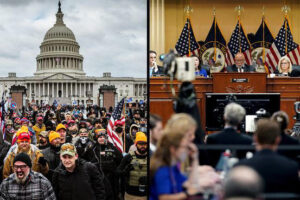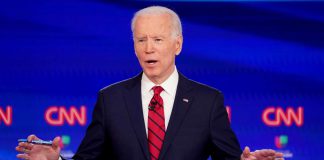JULY 22, 2022

WASHINGTON, D.C. —In a series of eight televised hearings, the House select committee investigating the Jan. 6, 2021, riot at the Capitol sought to paint a damning picture of a president willing to incite a mob to hang on to power after running out of options in reversing his election defeat.
The hearings, spanning about six weeks, laid out the committee’s case that the attack was the “culmination of an attempted coup,” as Chairman Bennie Thompson (D., Miss.) characterized it in his opening remarks in early June. The hearings shined a spotlight on dozens of witnesses, many speaking publicly for the first time, who testified that then-President Donald Trump leaned on state officials, the Justice Department, his own vice president and ultimately his most fervent supporters to try to stay in office.
The examination of Mr. Trump’s actions could deepen the former president’s legal peril, putting him at risk in a parallel Justice Department probe of drawing possible charges such as fraud, inciting a riot or obstructing the election’s certification, legal observers have said. The revelations could also weigh on Mr. Trump’s political aspirations as he considers another run for president, and have fueled efforts in Congress to clarify legislatively the vice president’s role in certifying the election.
In some of the hearings’ most significant new testimony, a former White House aide, Cassidy Hutchinson, said Mr. Trump knew that members of the crowd at his midday speech on Jan. 6 were armed when he urged them to march to the Capitol to try to stop lawmakers from certifying Joe Biden’s win. After some members of the crowd turned violent, Mr. Trump waited hours to call them off.
Mr. Trump has said he did nothing wrong and has called the select committee a witch hunt. After Thursday’s hearing, Mr. Trump criticized the proceedings and some of the testimony presented. “So many lies and misrepresentations,” he wrote on his social-media network, Truth Social.
The committee includes two Republicans, Reps. Liz Cheney of Wyoming, who serves as vice chairwoman, and Adam Kinzinger of Illinois, both political opponents of Mr. Trump. After House Speaker Nancy Pelosi (D., Calif.) rejected several proposed GOP members, House Minority Leader Kevin McCarthy (D., Calif.) boycotted the panel. That move has allowed Republican critics to paint the committee as partisan but has also kept GOP lawmakers from playing an active role in the proceedings.
Thursday’s hearing, the last scheduled before September, focused on the 187-minute period on Jan. 6 between Mr. Trump’s speech to a crowd on the Ellipse and the release of a video in which the president told the rioters to go home. According to the recorded testimony of an unnamed White House security official, some members of Vice President Mike Pence’s security detail feared for their lives and radioed in goodbyes to family members.
Mr. Trump, according to testimony shown Thursday, resisted repeated pleas from aides and family members to call off the rioters. Former Trump aides testified that some of his actions—particularly a tweet saying Mr. Pence “didn’t have the courage to do what should have been done”—fanned the flames.
The House committee now turns its focus toward writing a summary of its findings, which it is expected to release in the months ahead, although members have said they expect to hold more hearings. The panel, which consists of seven Democrats and two Republicans, will weigh whether to make a formal referral to the Justice Department for potential criminal prosecution.
Attorney General Merrick Garland hasn’t said whether any hearing testimony has altered prosecutors’ thinking or changed the direction of their separate probe. Prosecutors have charged about 850 people in connection with the Jan. 6 violence, including more than a dozen members of the Oath Keepers and Proud Boys groups charged with engaging in a seditious conspiracy against the U.S. Three have pleaded guilty to that charge.
Committee members presented testimony that those groups took a December 2020 tweet by Mr. Trump as a call to come to Washington, but the hearings didn’t establish direct ties between the White House and far-right groups.
The testimony by Ms. Hutchinson, an aide to Mr. Trump’s final chief of staff, Mark Meadows, has broadened some Justice Department officials’ view of the potential scope of their probe, people familiar with the matter said, though officials insist their investigative strategy hasn’t changed.
“This is the most wide-ranging investigation and the most important investigation that the Justice Department has ever entered into,” Mr. Garland said this week. “We have to get this right.”
The public hearings showed only a portion of the committee’s yearlong investigation, which included interviews of more than 1,000 witnesses and tens of thousands of documents. The hearings contained video clips of dozens of witnesses, including senior White House officials, but the full transcripts of their testimony haven’t been released.
Committee members have said they have questions that would like to explore further. Rep. Jamie Raskin (D., Md.) said he wanted to know why Mr. Trump was so adamant to get to the Capitol, as witnesses have testified.
“What exactly did he think was going to happen when he got up there?” he said on CNN Friday morning.
Republican lawmakers joined Democrats last year in condemning the attack, and some decried Mr. Trump’s actions as well. When the House quickly impeached Mr. Trump on a count of inciting an insurrection, 10 Republicans joined Democrats. In the Senate, all 50 members of the Democratic caucus plus seven Republicans voted to convict Mr. Trump, short of the two-thirds threshold required.
Republicans rejected calls for a bipartisan commission to investigate the riot, leading Democrats to instead set up the House panel. House GOP leaders have said they would wind it down if they win back control of the chamber.
A central question coming into the hearings was whether they would alter or harden the public’s impressions of the former president or the attack, and whether viewers would tune in. About 19.4 million people viewed the first hearing, on June 9, which was conducted during prime time. Subsequent hearings had sharply lower viewership, but rebounded to 13.2 million for the testimony by Ms. Hutchinson, according to Nielsen.
A Marist poll released Thursday found that half of American adults think Mr. Trump should be charged with crimes based on the evidence presented at hearings, but that only 28% think he will face criminal charges.
Polls indicate that GOP voters’ enthusiasm for Mr. Trump has softened since he exited the White House, but national surveys still show him ahead of the rest of the potential Republican field.
Over the course of the eight hearings, the committee produced a lineup of mostly senior Republican officials who testified that Mr. Trump and his allies carried out a wide-ranging effort to reverse his electoral loss. In the first hearing, Ms. Cheney said Mr. Trump’s efforts consisted of a multipart plan to overturn the 2020 presidential election, and subsequent hearings ticked through the themes.
Early witness testimony at the first hearing—video footage of former Attorney General William Barr—introduced a core argument that Mr. Trump marshaled claims of election fraud to block the transfer of power, despite being told repeatedly that the claims were false by aides and administration officials.
In a clip played at the first hearing, Mr. Barr said he “made it clear I did not agree with the idea of saying the election was stolen.” In a clip at the second hearing, he said of Mr. Trump: “I thought, boy, if he really believes this stuff, he has become detached from reality.” Mr. Barr resigned as attorney general in December 2020.
The committee also dug into the pressure Mr. Trump put on Mr. Pence, the subject of the third hearing, on June 16. The hearing included recorded testimony of Mr. Pence’s former chief of staff, Marc Short, and live testimony by Greg Jacob, a White House lawyer for the then-vice president, detailing their efforts to push back against Mr. Trump.
The hearing focused on testimony about an effort backed by Mr. Trump for Mr. Pence to reject electors in several battleground states as he presided over Congress’s certification of the Electoral College tally on Jan. 6. Mr. Jacob testified that Mr. Pence dismissed the plan as unlawful. J. Michael Luttig, a former federal judge and conservative lawyer who advised Mr. Pence, called the attempt to overturn the election “constitutional mischief.”
The committee’s fourth hearing, on June 21, pivoted to Mr. Trump’s pressure campaign on state officials to take steps to reverse his election loss. One focus was the former president’s Jan. 2, 2021, call with Georgia Secretary of State Brad Raffensperger, in which Mr. Trump asked him to find 11,780 votes to swing the election his way. Mr. Raffensperger, a Republican, testified that audits of the state’s election results showed no evidence of widespread fraud.
“The numbers are the numbers,” he told the committee. “The numbers don’t lie.”
A special grand jury in Fulton County, Ga., is seeking testimony from several attorneys who advised Mr. Trump on efforts to challenge the 2020 election results, including personal lawyer Rudy Giuliani.
The fifth hearing, on June 23, included testimony from senior Justice Department officials detailing the then-president’s efforts to enlist them in his plan to overturn the election. Jeffrey Rosen, former acting attorney general, described Mr. Trump’s attempt to replace him with another Justice Department official who he said had expressed a willingness to use the agency to help Mr. Trump continue his legal battles contesting the election results.
That official, Jeffrey Clark, proposed sending an official Justice Department letter to state legislatures in Georgia and other battleground states declaring a federal investigation into irregularities in the 2020 election, according to Mr. Rosen and another former Justice Department official, Richard Donoghue. The letter would have pressed the legislatures to meet in a special session to determine whether to send alternative slates of electors to Congress. Other Justice Department officials rejected the idea and said they and others would quit if Mr. Clark was elevated to run the department, The Wall Street Journal has previously reported.
The biggest surprise of the hearings came on June 28, when Ms. Hutchinson told the committee about a series of events that took place inside the White House in the days leading up to Jan. 6 and the day itself. Ms. Hutchinson said Mr. Trump was concerned that magnetometers were keeping armed supporters from his speech at the Ellipse. She said she overheard him saying something to the effect of, “I don’t effing care that they have weapons. They’re not here to hurt me. Take the mags away. Let the people in, they can march to the Capitol from here.”
She also described a scene in which Mr. Trump, after giving his speech at the Ellipse, grappled with a Secret Service agent inside a presidential vehicle after demanding to be driven to the Capitol. She said she was told about the event by Tony Ornato, who was White House deputy chief of staff. Secret Service officials have disputed the account.
Ms. Hutchinson said White House counsel Pat Cipollone warned that if Mr. Trump went to the Capitol that day, “We’re going to get charged with every crime imaginable.” Days after her testimony, the committee issued a subpoena for Mr. Cipollone, who testified behind closed doors on July 8.
The following hearing, the seventh, featured Mr. Cipollone’s recorded testimony. Videos of witnesses told a story of a contentious meeting with Mr. Trump on Dec. 18, 2020, in which White House lawyers squared off against his allies, including Mr. Giuliani, who was claiming widespread voter fraud. “I was not happy to see the people who were in the Oval Office,” Mr. Cipollone said. In recorded testimony, Mr. Giuliani said the White House lawyers were “not tough enough.”
Following the meeting, in the early morning hours of Dec. 19, Mr. Trump tweeted: “Big protest in D.C. on January 6th. Be there, will be wild!” The committee and witnesses said the tweet amounted to a call to action to far-right groups to come to Washington.
The committee also provided evidence, including a draft tweet, that Mr. Trump planned before his Jan. 6 speech to direct attendees toward the Capitol, rather than it being a spontaneous comment.
At Thursday’s hearing, the committee played a recording of a deposition from Gen. Mark Milley, chairman of the Joint Chiefs of Staff, who commented on Mr. Trump’s reaction on Jan. 6.
“You’re the commander in chief, you’ve got an assault going on in the Capitol of the United States of America, and there’s nothing?” he said. “No call? Nothing? Zero?”










































































































